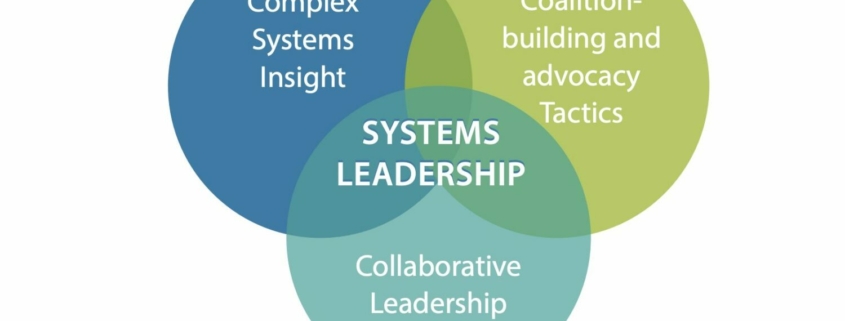World Economic Forum: Systems leadership can change the world – but what exactly is it?
A Systems Leadership article by Lisa Dreier, Managing Director, Advanced Leadership Initiative, Harvard University, Sir David Nabarro, Co-Director, Institute of Global Health Innovation, Imperial College London, Jane Nelson, Director, Corporate Responsibility Initiative,Harvard Kennedy School of Government. This article was originally published on the World Economic Forum on 24 September, 2019 here.
As world leaders and activists gather in New York this week to address the climate crisis and the faltering rate of progress toward the UN’s Sustainable Development Goals (SDGs), the calls for systemic change are getting ever louder. Systems change is an inspiring goal – but how can we achieve it?
Transforming a complex system – such as the energy, health or food system – is a monumental task requiring coordinated action by people with very different viewpoints. Systems-change initiatives often engage hundreds of organizations – governments, companies, civil society organizations, worker associations, research institutions and others – combining their capacities to achieve a shared goal.
These large-scale initiatives are often driven and supported by people who fit a certain profile – those who are able to catalyze and empower collective action among others, rather than controlling or directing the action themselves. These people are increasingly described as systems leaders.

A balancing act Image: Harvard Kennedy School
We studied examples of systems leaders working on diverse issues around the world, and found some striking similarities. Systems leaders – whether they are global leaders or community activists, working in Europe, Asia, Africa or the Americas – often apply a similar set of tactics and have similar experiences leading large, complex initiatives. We summarized some of the key elements and success factors of systems leadership in a new report in the interest of encouraging others in the global community to apply and refine this approach.
Systems leadership: a tool for our times
Systems leadership is a set of skills and capacities that any individual or organization can use to catalyze, enable and support the process of systems-level change. It combines collaborative leadership, coalition-building and systems insight to mobilize innovation and action across a large, decentralized network.
Two very different examples illustrate what it can look like in practice. The 2015 Paris Agreement, signed by 195 countries with support from thousands of organizations, was spearheaded by Christiana Figueres, a global diplomat who emphasized practicality, flexibility and collaboration to bring stakeholders onboard, securing an historic agreement. At a more local level in Richmond, California, a community organizer named Najari Smith founded a new venture called Rich City Rides, galvanizing community members, local businesses and city government to address the interconnected challenges of employment, health and environmental sustainability among low-income communities of color in the city.
These two leaders operated in very different spheres, but they used some similar tactics: combining a deep understanding of the systemic issues they wanted to address; an ability to engage and align diverse stakeholders around shared goals; and an emphasis on empowering action and collaboration by a broad network of organizations.
Systems leaders apply an unusual combination of skills and attributes to mobilize large-scale action for systems change. Like many leaders, they tend to be smart, ambitious visionaries with strong skills in management and execution. Unlike traditional leaders, they are often humble, good listeners, and skilled facilitators who can successfully engage stakeholders with highly divergent priorities and perspectives. Systems leaders see their role as catalyzing, enabling and supporting widespread action – rather than occupying the spotlight themselves.
Systems leadership in action
The systems leadership approach is well-suited to complex challenges that require collective action, where no single entity is in control. However, the approach is challenging – involving high transaction costs, ambiguous outcomes and long timeframes. It is best applied to complex issues that cannot be solved through more direct means.
We distilled five key elements of the systems change process into the ‘CLEAR’ framework for leading systems change. These five elements are not necessarily sequential – they may overlap or repeat in cycles throughout the course of an initiative.
1. Convene and commit
Key stakeholders engage in moderated dialogue to address a complex issue of mutual concern. They define shared interests and goals, and commit to working together in new ways to create systemic change. For example, the We Mean Business Coalition engaged nearly 1,000 leading companies to advocate for ambitious, science-based climate policy, and has made over 1,500 action commitments.
2. Look and learn
Through system mapping, stakeholders jointly build a shared understanding of the components, actors, dynamics, and influences that create the system and its current outcomes, generating new insights and ideas. For example, The Global Alliance for Improved Nutrition targets specific gaps in the nutrition system, working to catalyze and scale market-based solutions, and targeting vulnerable populations who are most in need.
3. Engage and energize
Strong stakeholder engagement is built through continuous communication to build trust, commitment, innovation and collaboration. Inspiration, incentives and milestones help drive progress and maintain momentum. For example, the New Vision for Agriculture initiative engaged over 650 organizations and 1,500 individual leaders around the world, catalyzing action in 21 countries including over 90 value-chain projects.
4. Act with accountability
Shared goals and principles set the direction of the initiative, while measurement frameworks help track progress. Coordination and governance structures can be developed as initiatives mature. For example, the Every Woman Every Child movement mobilized hundreds of action commitments towards its global strategy, monitoring progress through a unified accountability framework, with oversight from a high-level steering group and coordination by a global secretariat.
5. Review and revise
Stakeholders review progress regularly and adapt their strategy accordingly. Adopting an agile, flexible, innovative and learning-centered approach allows for evolution and experimentation. For example, the 2030 Water Resources Group evolved its organizational structure through several stages, commissioning external evaluations to both review its progress and recommend opportunities to increase its impact.
While the CLEAR Framework appears quite structured, the reality of the systems change process is often messy and ambiguous. Many stakeholders describe the experience of systems leadership as a journey of discovery that evolves over time, leading to moments of discovery or insight – what we describe as ‘Aha! moments’ – that crystallize each step of the journey.
Mainstreaming the systems leadership approach
While the concept of systems leadership makes intuitive sense to many stakeholders, it is not yet widely embraced and practiced. Mainstreaming its application will require a broader and more coordinated effort to develop research, share knowledge and build capacity. A number of philanthropists, consultancies and academics are active on these fronts, but they are not always well-connected. New platforms are needed to connect practitioners and experts, share insights and accelerate learning to support a wider array of organizations in applying Systems Leadership to advance progress toward the SDGs.








Leave a Reply
Want to join the discussion?Feel free to contribute!